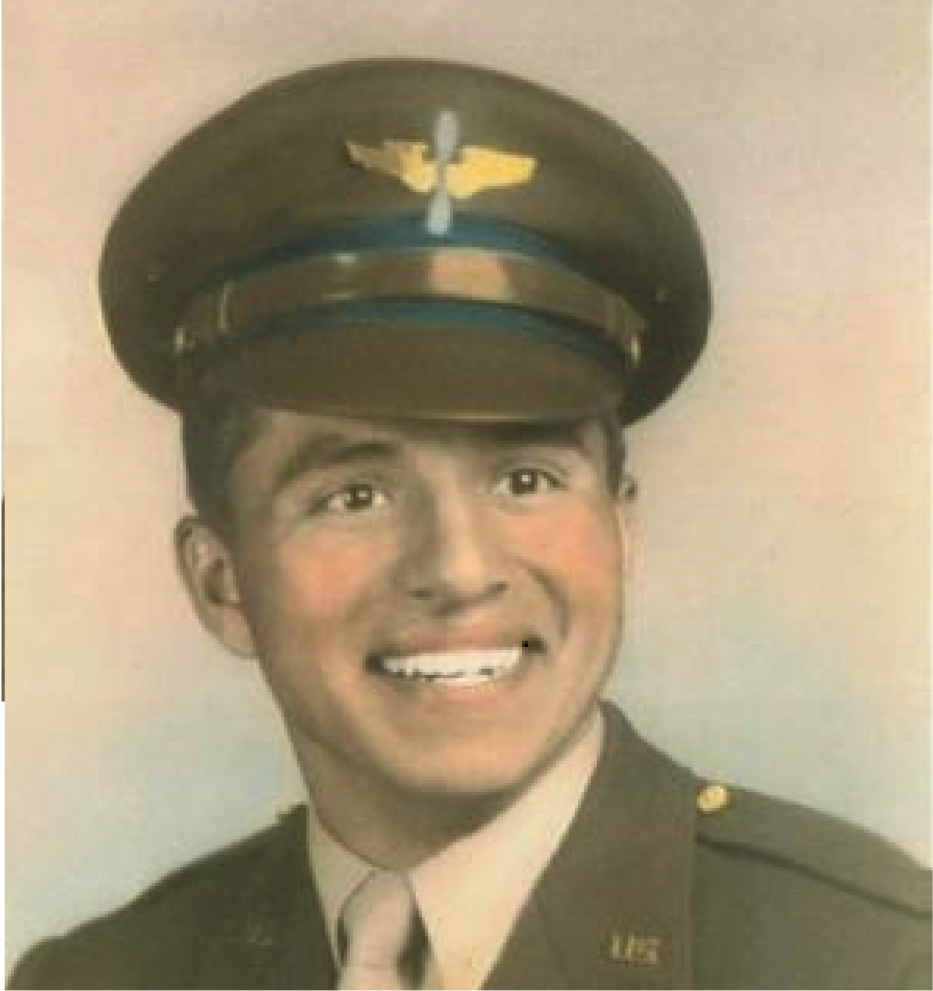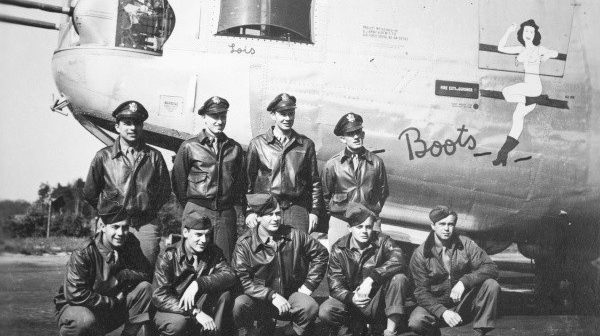 The Grampaw Pettibone Squadron was honored to have as guest speaker, Mr. Bob Ruiz share his experience as a 21 year-old, 1st Lt. Army Air Corps pilot in command of a B-24 during WWII. He earned the Distinguished Flying Cross and seven Air Medals during his time in the service. GPS member Bob Olds introduced our speaker.
The Grampaw Pettibone Squadron was honored to have as guest speaker, Mr. Bob Ruiz share his experience as a 21 year-old, 1st Lt. Army Air Corps pilot in command of a B-24 during WWII. He earned the Distinguished Flying Cross and seven Air Medals during his time in the service. GPS member Bob Olds introduced our speaker.
Bob grew up in Pacific Beach, a community near La Jolla, CA, graduating high school in 1941. He shared a little bit of his family history. Bob took his entrance exam for the Army Air Force in early 1942 and was called up in early 1943. Bob was initially sent to Lincoln, Nebraska to learn to be a soldier. He was then sent to Missoula, Montana for basic training before being sent to Santa Ana Army Air Base for preliminary pre-flight training as an aviator or crew member. At Santa Ana Army Air Base he was stationed for three months of training where he was tested and selected for pilot training.
Pilot training took place at Santa Maria Airfield where Bob had to qualify in a Stearman aircraft, PT-17 during primary training. According to Bob, if a trainee did not solo in a Stearman aircraft within seven hours of training, he was washed out of flight school. Upon completing primary training, Bob moved on to advance training at Douglas, AZ, in a twin engine aircraft, the AT-9. Bob was able to solo within the nine hour requirement and after successfully completing advance training, he then was sent to B-24 pilot training in Pueblo, Colorado, where he was assigned a crew. After three months training he and his crew were assigned to the 8th Air Force, shipped out to Hethel Air Base, near Norwich, England – headquarters of the 389th Bomb Group. They sailed from New York Harbor to England on a 14 day voyage in July of 1944, just one month after the Normandy, D-Day landing.
 Bob described the first mission he flew as a new pilot. Waking at 3 in the morning, getting breakfast and then going into the briefing room to find out their mission for the day. A large board is covered in front of the room and the briefer removes the curtain to show the mission and route of flight. As a pilot Bob sat in the left seat, however, a more experienced pilot commanded the mission and flew from the right seat. Bob flew the plane from lift off to the IP-Initial Point, about five minutes from the target, when the more experienced pilot took over. Bob indicated the target, the city of Hannover, west of Berlin. It was a clear day on a Sunday over the target when all of a sudden the sky suddenly filled with explosions. This was Bob’s first experience with flak. The plane next to him took a direct hit and disappeared. Though the flak and enemy fighter attack was heavy, he completed the mission and returned to his base without any injuries. In talking about his crew, Bob noted that two of the gunners in his crew were just 17 and 18. Returning from the first mission, Bob checked the next day’s schedule and noted he was set to fly. Compared to his first mission, the second one was not too bad, very quiet.
Bob described the first mission he flew as a new pilot. Waking at 3 in the morning, getting breakfast and then going into the briefing room to find out their mission for the day. A large board is covered in front of the room and the briefer removes the curtain to show the mission and route of flight. As a pilot Bob sat in the left seat, however, a more experienced pilot commanded the mission and flew from the right seat. Bob flew the plane from lift off to the IP-Initial Point, about five minutes from the target, when the more experienced pilot took over. Bob indicated the target, the city of Hannover, west of Berlin. It was a clear day on a Sunday over the target when all of a sudden the sky suddenly filled with explosions. This was Bob’s first experience with flak. The plane next to him took a direct hit and disappeared. Though the flak and enemy fighter attack was heavy, he completed the mission and returned to his base without any injuries. In talking about his crew, Bob noted that two of the gunners in his crew were just 17 and 18. Returning from the first mission, Bob checked the next day’s schedule and noted he was set to fly. Compared to his first mission, the second one was not too bad, very quiet.
Bob stated that every three weeks he would get leave and would go to London for a rest. He explained that he volunteered to be a pilot to have a good time, eat in a mess hall, have a warm bed to sleep in and not be on the ground like the GIs living in foxholes, eating K rations and in the winter time freezing their you know what. He said he felt sorry for them.
In speaking about WWII statistics, Bob indicated that total US casualties exceeded 408,000 personnel, a high percentage were 19-20 years old. The 8th Air Force suffered over 26,000 casualties, plus numerous POW and MIA.
When describing his experience, Bob stated that he would have to fly 35 missions before going home. Some missions lasted 10-12 hours, taking 4 hours to form up. Major targets had as many as 1000 planes participating. He noted that fighter pilots had to fly many more missions before they were sent back home. While fighter pilots could take evasive action when attacked, the bombers had to maintain formation in order to complete their mission and deliver their bombs on target, a more challenging assignment.
Bob spoke about meeting Hollywood actor Jimmy Stewart, who was assigned to a bomb group at the same base as Bob, where as a Colonel he was assigned as a pilot. He described him as a ‘heck of a nice guy’.
Bob stays active today with the Freedom Committee, as a Docent at Lyon Air Museum and was a participant as a member of the Honor Flight, to visit Washington, DC. When he returned from his flight, the airport honored the members of the flight by having the fire trucks spray the plane as it pulled in to the gate.
As a Freedom Committee member, he visits local high schools and present information about WWII. According to Bob only a few students knew some information about WWII.
Our speaker related his experience about a business trip that occurred many years after the war. While sitting in a hotel bar he had a conversation with another customer and noticed an accent. When Bob inquired as to where he was from, the customer answered Germany. In asking what he did in the war, the man answered, Luftwaffe. Bob told the stranger he was in the 8th Air Force flying bombers and the stranger asked him what was the color of the tail on his plane. Bob answered, it had a white stripe and the stranger remarked, ‘I remember you.’
Bob took questions at the end of his talk, the first one asking about the frequency of flying the same plane. Sometimes he flew the same plane, however, as a rule you flew whatever was available. Bob answered a question regarding aircraft model and noted that his unit only had B-24s, though adjoining units flew B-17s. A number of questions regarding comparison of B-17 v B-24. The B-24 was a faster plane, had a longer range and greater bomb load. Asked if it was easy to fly, Bob remarked, ‘for me it was’.




